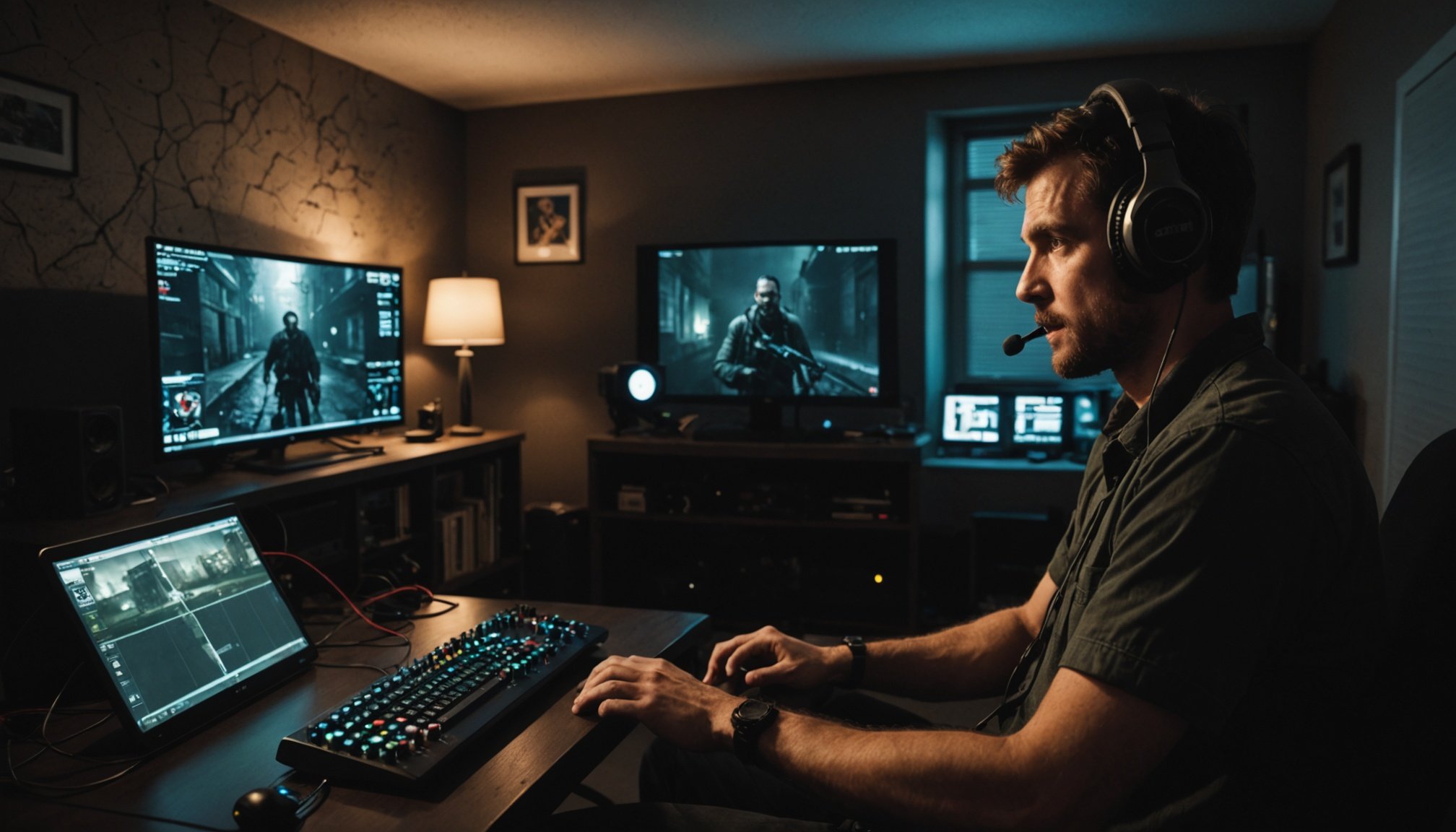The Importance of Audio in Horror Gaming
Audio in horror gaming is crucial for crafting tension, fear, and creating immersive experiences. From haunting melodies to eerie soundscapes, sound plays a pivotal role in evoking emotions. The way a simple creak or distant howl can send shivers down your spine is testament to the psychological impact sound has on players.
Historically, the evolution of audio in horror games has been transformative. In early games, sound effects were basic, often limited by the technology of the time. Yet, despite these limitations, developers found creative ways to use audio to unsettle players. As technology advanced, so did the sophistication of audio in horror gaming. Detailed sound design and high-quality audio files became standard, helping to amplify the emotional intensity of these games.
Also to discover : Revolutionizing rpg character diversity: harnessing ai voice synthesis for immersive experiences
The psychological effects of sound are profound in horror gaming. Sounds can manipulate emotions and trigger responses, such as increased heart rate and heightened anxiety. This is due to how our brains are wired to respond to auditory cues. Effective sound design uses these cues to guide players’ emotions, dictating when to feel dread or when to brace for an impending scare.
Advanced Audio Technologies Enhancing Immersion
Technological advancements have profoundly transformed the gaming experience, with dynamic audio technologies being at the forefront.
Have you seen this : Crafting ethical ai in open-world games: a developer”s comprehensive guide
Overview of Spatial Audio
Spatial audio is a technology that recreates how humans perceive sound in a three-dimensional space. This advancement allows players to distinguish the direction and distance of sound, thus deepening the immersive experience. Unlike traditional stereo sound, spatial audio technology enables sound to be perceived from all directions, giving a realistic audio experience. In gaming, this translates to a heightened awareness of surroundings, making the gameplay far more engaging and responsive.
The Role of 3D Soundscapes
3D soundscapes contribute significantly to the realism in games by simulating acoustic environments. These soundscapes incorporate layers of sound that interact based on the player’s movements and actions. For instance, in horror games, the eeriness is amplified through carefully designed 3D soundscapes—footsteps sounding behind, whispers from unknown directions. The ability of 3D soundscape to create such an intricate audio design intensifies the player’s emotional response.
Innovations in Audio Design
Recent innovations prioritize realistic audio design over traditional techniques. Newer horror games leverage dynamic strategies that contrast traditional audio methods, creating more intense and frightening experiences. Developers now employ dynamic audio techniques to ensure that every sound adapts to the game’s evolving narrative, enhancing prior attempts at static sound effects.
Case Studies of Effective Audio Use in Horror Games
In the realm of immersive horror games, audio innovations have become a game-changer. A prime case study is the renowned game Silent Hill, where eerie ambient sounds heightened tension, offering players an unforgettable experience. Audio examples in Silent Hill reveal the strategic use of unnerving background noises and sudden audio cues that differentiate casual play from deeply immersive moments. Another hallmark is Resident Evil 7, which showcases a substantial improvement in audio design, using 3D sound to amplify terror and dramatic tension.
Comparing reactions across titles like Dead Space and Amnesia: The Dark Descent, players often cite audio as a pivotal element that elicits genuine fear. These games effectively employ sound to guide emotions, suggesting that executed skillfully, audio can control a player’s psychological state. The differences in player reactions can be stark; some find audio-augmented gameplay to be more immersive and terrifying, while others admire the craft without a visceral response.
Lessons developers might extract from these case studies include the importance of subtlety in sound design and the potential to create memorable player experiences. Balancing between overstimulation and underutilisation is essential, ensuring audio serves as a bridge between the player and the game’s chilling atmosphere.
Psychological Effects of Sound in Horror Gaming
Sound plays a crucial role in shaping the psychological effects of audio within horror games. When used effectively, it can trigger various fear responses and enhance emotional engagement. Understanding how these elements interact provides deeper insights into player experiences.
Sound and Fear: A Psychological Perspective
The relationship between sound and fear is complex. Sounds can evoke fear through certain frequencies and patterns that tap into primal instincts. Loud, sudden noises, such as screams or crashes, can startle players, leading to an adrenaline rush. Meanwhile, low-frequency sounds cause unease, as they mimic natural warning signals in the wild.
The Use of Silence in Building Suspense
Silence, or the absence of sound, can be just as effective. It creates tension and anticipation, as players subconsciously prepare for a sudden auditory assault. This technique, known as dynamic contrast, manipulates players’ expectations, heightening their sensations and emotional engagement.
Feedback from Psychologists on Audio in Gaming
Psychologists emphasize how sound triggers physiological responses. When layered with unexpected audio cues, it can make the gameplay experience more intense. Experts suggest balancing quieter periods with sudden auditory impacts to create memorable, fear-inducing soundscapes. This strategic design of sound contributes significantly to the immersive nature of horror gaming.
Implementation Strategies for Game Developers
In the realm of game development strategies, dynamic audio plays a pivotal role in enhancing player immersion. Integrating such audio into existing frameworks can be achieved using several techniques. Game developers might consider middleware solutions like Wwise or FMOD, which facilitate the smooth incorporation of dynamic audio without extensive code rewrites.
Budget considerations are critical when implementing audio technology. Developers should evaluate the cost-effectiveness of these middleware options compared to custom-built systems. The key is balancing high-quality audio with financial prudence. For indie developers, utilizing ready-to-use plugins can save time and resources.
Collaboration between sound designers and developers is essential for optimal integration. Sound designers bring a unique perspective on what makes audio truly immersive. Working together from the early stages ensures that soundscapes align with the game’s mechanics and narrative. This partnership can involve regular meetings and shared creative sessions, transforming individual efforts into a cohesive audio experience.
Prioritising these strategies not only enhances player immersion but also elevates the game’s overall quality. Deployment of dynamic audio in a well-planned manner can set a game apart, offering players an unforgettable auditory journey while aligning with developers’ budgetary frameworks.
User Experiences and Feedback
Understanding player feedback is crucial for evolving horror gaming experiences. Active community opinions on game elements, particularly audio, shape how games are perceived and improved. Let’s explore how player feedback drives these changes.
Gathering Player Experiences
Players dive into horror games not only for the thrill but to immerse themselves in chilling narratives. Community forums and social media provide platforms for sharing real-time experiences, influencing peers and developers alike. Audio, often highlighted, creates tension and atmosphere, pivotal in horror gaming experiences.
User Reviews and Testimonials
User reviews are rich with insights into what works and what needs tweaking. Many emphasize the role of sound – creaking floors and eerie whispers enhance the fear factor. Testimonials from dedicated community opinions point out specific moments of genuine horror, often attributing a game’s success to its auditory landscape.
Developer Responses to Player Feedback
Developers listen closely to gather player feedback for refining audio elements in horror gaming. Through updates and patches, they incorporate community suggestions, ensuring an evolving and responsive gaming experience. This iterative process not only enriches the player experience but drives advancements in audio technology, keeping horror games at the forefront of innovation.











